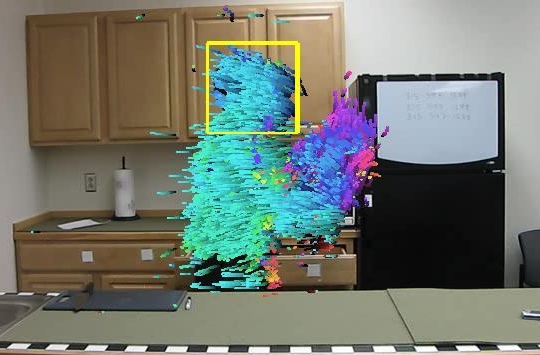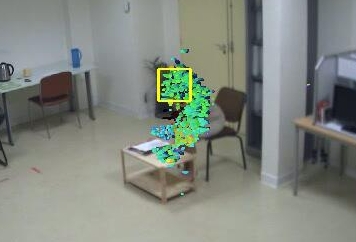Section: New Results
Human Action Recognition in Videos
Participants : Piotr Bilinski, François Brémond.
keywords: Action Recognition, Contextual Features, Pairwise Features, Relative Tracklets, Spatio-Temporal Interest Points, Tracklets, Head Estimation.
The goal of this work is to automatically recognize human actions and activities in diverse and realistic video settings.
Over the last few years, the bag-of-words approach has become a popular method to represent video actions. However, it only represents a global distribution of features and thus might not be discriminative enough. In particular, the bag-of-words model does not use information about: local density of features, pairwise relations among the features, relative position of features and space-time order of features. Therefore, we propose three new, higher-level feature representations that are based on commonly extracted features (e.g. spatio-temporal interest points used to evaluate the first two feature representations or tracklets used to evaluate the last approach). Our representations are designed to capture information not taken into account by the model, and thus to overcome its limitations.
In the first method, we propose new and complex contextual features that encode spatio-temporal distribution of commonly extracted features. Our feature representation captures not only global statistics of features but also local density of features, pairwise relations among the features and space-time order of local features. Using two benchmark datasets for human action recognition, we demonstrate that our representation enhances the discriminative power of commonly extracted features and improves action recognition performance, achieving recognition rate on popular KTH action dataset and on challenging ADL dataset. This work has been published in [36] .
In the second approach, we design new representation of features encoding statistics of pairwise co-occurring local spatio-temporal features. This representation focuses on pairwise relations among the features. In particular, we introduce the geometric information to the model and associate geometric relations among the features with appearance relations among the features. Despite that local density of features and space-time order of local features are not captured, we are able to achieve similar results on the KTH dataset ( recognition rate) and recognition rate on UCF-ARG dataset. An additional advantage of this method is to reduce the processing time of training the model from one week on a PC cluster to one day. This work has been published in [37] .
In the third approach, we propose a new feature representation based on point tracklets and a new head estimation algorithm. Our representation captures a global distribution of tracklets and relative positions of tracklet points according to the estimated head position. Our approach has been evaluated on three datasets, including KTH, ADL, and our locally collected Hospital dataset. This new dataset has been created in cooperation with the CHU Nice Hospital. It contains people performing daily living activities such as: standing up, sitting down, walking, reading a magazine, etc. Sample frames with extracted tracklets from video sequences of the ADL and Hospital datasets are illustrated on Figure 22 . Consistently, experiments show that our representation enhances the discriminative power of tracklet features and improves action recognition performance. This work has been accepted for publication in [38] .




